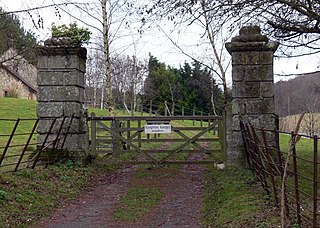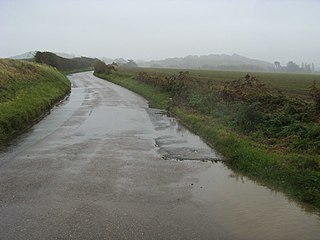Related Research Articles

Thorley is a village on the Isle of Wight, 1+1⁄2 miles (2.4 km) from Yarmouth in the northwest of the island and is 9 miles (14 km) west from Newport.
Josiah Hort, was an English clergyman of the Church of Ireland who ended his career as archbishop of Tuam.

The Worsley family is an English family that is derived from Sir Elias de Workesley, a Norman knight who was a youth at the time of the Norman conquest. He later accompanied Duke Robert II of Normandy on the First Crusade and was buried at Rhodes.

The Great Budbridge Manor is a manor house just south of Merstone, near Arreton, Isle of Wight, England. Fish ponds on the grounds appear medieval.

Knighton Gorges Manor was one of the grandest manor houses on the Isle of Wight. Located in the hamlet of Knighton, near Newchurch, it is reported to be one of the most haunted locations on the Isle of Wight.

Nunwell House, also Nunwell Manor, is a historic English country house in Brading, Isle of Wight. Located 3 miles (4.8 km) south of Ryde, the Tudor and Jacobean style house also has later additions. The house contains family militaria. It was occupied by the Oglander family from Norman times until 1980. Nunwell House is a Grade II* listed building.

Apse Manor is a manor house on the Isle of Wight, situated just within the eastern boundary of the Newchurch parish. The house is pleasantly situated just to the north of the high road from Shanklin and as of 1912 retained a room with a stone fireplace and a heavy panelled Tudor ceiling.
Ashey Manor is a manor house in Ashey on the Isle of Wight, situated within the Newchurch parish. It was historically linked with Ryde Manor.
Cleaveland Manor is a manor house on the Isle of Wight, situated within the Victoria parish.
Smallbrook Manor is a manor house on the Isle of Wight, lying at the north-eastern boundary of Newchurch parish. It doubtless took its name from the stream that here forms the boundary of the parish. It is of ancient origin, as in 1280 William de Smallbrook (Smalebrook) granted land to his son Hugh. It was held at the end of the 14th century by the Wyvill family, and remained in their possession until 1491–2, when Stephen Wyvill, the last of the family, sold it to Henry Howles. Smallbrook passed in the Howles family until the reign of Elizabeth, when it was divided between co-heirs and sold to Sir William Oglander. In the court held at Ashey Manor, 1 November 1624, Sir John Oglander was returned as a freeholder and free suitor of the manor for his farm called 'Smallbroke.' The estate has since descended with Nunwell and as of 1912 was held by Mr J. H. Oglander, who had the Court Rolls in his possession.

Wolverton Manor is a manor house in Shorwell, on the Isle of Wight, England. The original house was started by John Dingley, Deputy Governor of the Isle of Wight. The Jacobean style home, built by Sir John Hammond after the death of Sir John Dingley, is the second house built on the site. There is a two-storey porch which features a flat roof and hollow angle columns.
Horringford Manor is a manor house on the Isle of Wight, situated in the parish of Arreton.
Rookley Manor is a manor house on the Isle of Wight, situated in the parish of Arreton. Though originally in Godshill parish, it is now included for the greater part in the boundaries of South Arreton.
Sir John Holcroft of Holcroft Hall, Culcheth, was a soldier, politician, and landowner of the Tudor period. He was returned twice as a member of the English parliament for Lancashire.
Alverstone Manor is a manor house in Alverstone in the parish of Brading on the Isle of Wight.
Barnsley Manor is a manor house in the parish of Brading on the Isle of Wight.
Milton Manor is a manor house in the parish of Brading on the Isle of Wight, in England.
Sandown Manor is a manor house in the parish of Brading on the Isle of Wight.

The Manor of Totteridge was located in Totteridge, Hertfordshire, in an area that is now part of the London Borough of Barnet. The manor was historically associated with the Manor of Hatfield. The original manor house was demolished before 1821 and the manorial estate known as Totteridge Common was transferred to a charity, the Totteridge Manor Association, in 1954.
Sir Tristram Dillington, 5th Baronet of Knighton, Isle of Wight was a British Army officer, landowner and Whig politician who sat in the House of Commons between 1707 and 1721.
References
This article includes text incorporated from William Page's "A History of the County of Hampshire: Volume 5 (1912)", a publication now in the public domain
- 1 2 3 "Victoria County History". British History Online, University of London & History of Parliament Trust. 1912. Retrieved 6 July 2011.CS1 maint: discouraged parameter (link)